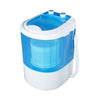Laundry chutes can be a very convenient way of transporting dirty clothes to the laundry room. However, some people are concerned that laundry chutes might be a fire hazard, helping spread flames upward. Are they? Here is what some experts have to say on the topic:
“They can have a chimney effect; you can get smoke and fire up through all the floors,” said Karen Harris of the American Institute of Architects.
But wait, noted residential fire expert Roy Marshall: “A stairway does the same thing.”
And fire code expert Bill Rehr has a laundry chute in his Wheaton, Ill., home. “We use it all the time,” he said. “My son stuffs his Levi’s down there.”
And, experts point out, most laundry chutes have doors, which further reduces the spread of a fire.
Still, they recommend checking with a home inspector or contractor to make sure your laundry chute doesn’t empty near a hot-water heater or furnace.
But neither Marshall, director of the Residential Fire Safety Institute, nor Rehr, a senior staff member at the International Code Council, knows of any laws prohibiting laundry chutes in single-family homes.
If you’re still concerned, they say, ask at your city hall.
So relax, laundry masters and mistresses, your chute is probably quite safe.
Your attachment to it, on the other hand, may be a bit odd.
People still recall decades-old laundry-chute adventures.
They yell messages through chutes, and use them to eavesdrop on basement conversations. They have special poles to keep the chutes clear.
They remember making mischief with them as children, then grow up trying to keep their own youngsters – and pets – from doing the same thing.
Gopal Ahluwalia of the National Association of Home Builders is familiar with such enthusiasm for laundry chutes. He also said there’s no data on their numbers.
The association recently assembled two focus groups in San Antonio to determine what laundry-room features were important to homeowners.
“Both groups asked us the same exact question. That was a surprise,” Ahluwalia said. “In each group someone said, ‘Can you build in a laundry chute?’“
There’s little, if any, research on the history of laundry chutes. Martin Hackl, a building restoration contractor and consultant in Oak Park, Ill., has seen them in homes built as long ago as 1914.
“I think they were probably earlier than that,” Hackl said. “I would guess they go back to the 19th century.”
He added: “I’ll never live in another two-story house without one.”
The laundry chute in Doug Johnson and Brett Copeland’s restored Washington, D.C., brownstone is just as adored.
“Our house is quite tall, a basement and three floors,” Johnson said. “We have laundry chutes in the kitchen and every hall, which I love.”
Johnson said he does the laundry, so partner Copeland “thinks it’s magic” – he puts his dirty laundry down the chute and clean clothes appear again.
The only snag is, well, snags. “Stuff does get hung up in it sometimes,” Johnson said. “We have an old broom handle so when it gets blocked you stick the pole up there and 50 pounds of clothes fall on your face.”
Architect Harris, of Denver, said most laundry chutes are framed into a home when it’s built. They’re often drywalled or lined with ductwork, with a door at the top or on each floor.
Homeowners looking for something fancy might consider what may be the most expensive option, a push-button laundry chute door from Herbau Creations of America in Naples, Fla.
Manufactured in France by a company dating to 1857, the Herbau Ariege comes in five different finishes ranging in price from $850 to $1,000. “We sell a lot of them,” said Herbeau’s Randi Durgin.













